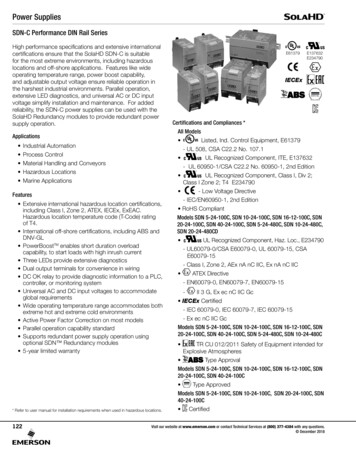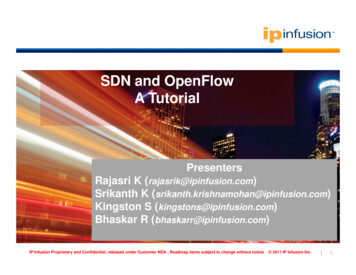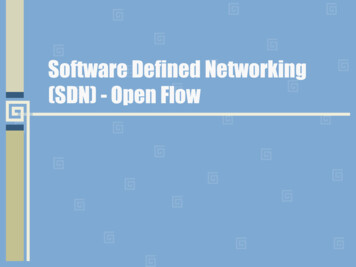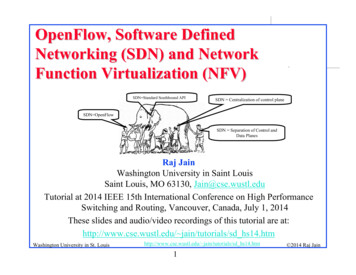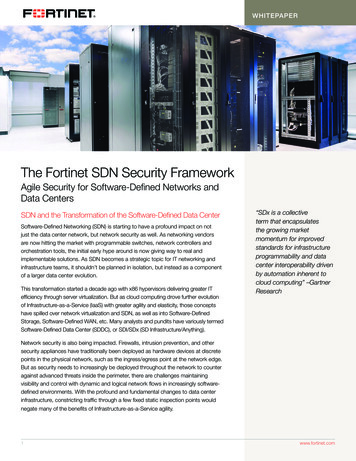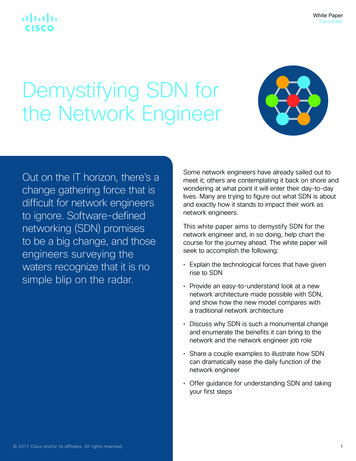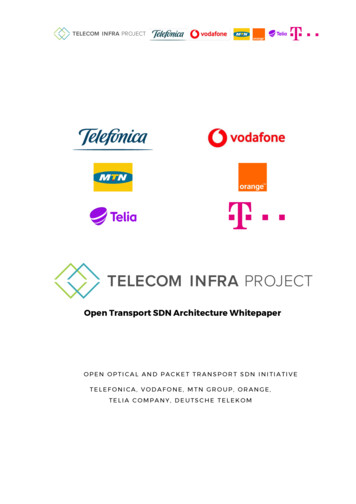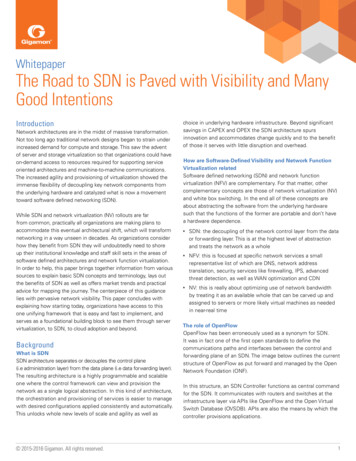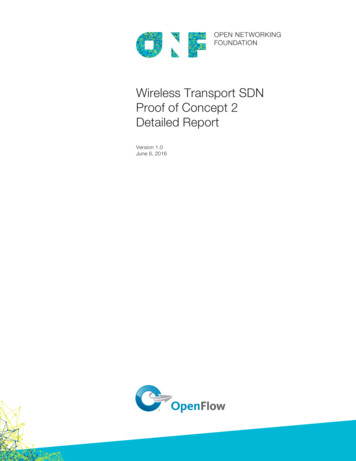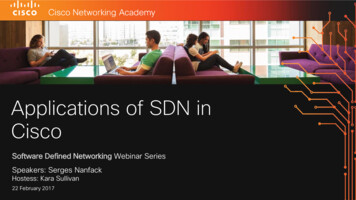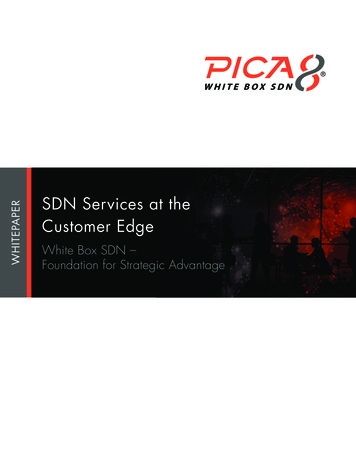
Transcription
WHITEPAPERSDN Services at theCustomer EdgeWhite Box SDN –Foundation for Strategic Advantage
SDN Services at the Customer EdgeWhite Box SDN – Foundation for Strategic AdvantageBusinesses and consumers are always clamoring for more services, more bandwidth, andlower prices, and service providers large and small must find ways to deliver. Subscribersare used to dialing up new capabilities on their smartphones with the click of a button, andthey want Internet services to have the same ease of use. For their part, service providerswant to enable customer self-provisioning, new services, and automated provisioning notonly as competitive differentiators but also as a way to reduce costs and speed time-torevenue or time-to-payback for new services. Software-defined networking (SDN) is a keyto service agility and self-service provisioning for service providers and their customers.How Does SDN Help?Simply put, SDN helps service providers monetize their networks. By implementing policybased control over the network, SDN enables very rapid implementation of new services inways that would be impossible under today’s Layer 2/Layer 3 networking models.Network administrators interact with software on an SDN controller to set policies and spinup services, and the controller implements those policies and services on network switches.By disaggregating hardware and software, SDN creates new levels of service agility.It also enables the use of white box switches, which save CAPEX when compared withtraditional edge switching and routing solutions.Meter, match, and act are the three steps SDN undertakes to execute tasks in a policydriven network. SDN enables the metering of traffic conditions, application and userbehavior to match those conditions against a set of pre-defined criteria and then to act onthe match according to a policy. Part of a policy framework is to pre-set conditions thatare metered against.This embedded network intelligence can enable customers to drive the network themselves.One application might be a customer dashboard as depicted in Figure 1, where customerscan select the amount of bandwidth, the duration, and the latency level. For example,this would enable a business customer to throttle up bandwidth for three hours for abackup to the off-site data center or cloud, and then throttle the bandwidth back down toconserve spending. With SDN, these kinds of automated operations give service providerstremendous agility once set up, without any effort on their part to scale and enable this selfservice / utility mindset.1Mbps1hr730hrLowBest EffortFigure 1. Customer-driven service portal1WHITEPAPER1000Mbps
Disaggregation is the KeyDisaggregation is the key to network abstraction and flexibility. By freeing themselvesfrom legacy models of tightly coupled hardware and software, service providers canspeed provisioning and automate processes, thereby saving money and improvingservice agility for their customers.Servers, PCs, and most smartphones have disaggregated hardware and software,and it’s time for this trend to overtake the network. With a disaggregated network, thenetwork OS becomes the abstraction layer, and white-box switching hardware reducesCAPEX and OPEX. Here’s the difference:Suppose a customer wants a new service, and your switches were implementedas traditional, fully integrated stacks. If the new service required a specific feature,the provider would first need to upgrade the network, and this could take weeks(or potentially months) to procure, install, and configure the new equipment. With adisaggregated hardware/software model, implementing the new service can be donein less than 5 minutes – it’s a simple matter of deploying new software. More and moreservice providers are seeing this flexibility as critical to their business success.Service Injection at the EdgeThere are three service injection points, or service edges, in a service provider network: thebusiness customer’s hosted data center, the business customer premises, and the last mile tothe consumer. At these service edges, we can drop in a SDN-enabled white box switch toimplement SDN and enable self-provisioning networks to better support new applicationsfor these a centersFigure 2. Services in a white box SDN-driven networkVxLAN & NSX architecture and configuration2
The prime examples of these SDN-driven services are called out in Table 1.Business NeedConnectivity –Smart pipesService Liquid bandwidth Metered access QoS on demandSDN Features OpenFlow metering andaction matched rules OpenFlow control ofMPLS headers Interoperable with leadingcontrollers such as ONOS,ODL, HP VAN, and RyuDynamicallyprovisioned VPNs On demand disasterrecovery (DR) Setting up multi-tenantbuildings Hybrid Cloud servicesIT operationsand configurationmanagement Self provisioning Automation / DevOps API Integration VXLAN, NVRE, L2/L3oGRE Network virtualization andorchestration integration OpenFlow control of BGP RESTful, Linux andOpenFlow APIs Network automation:Chef, Puppet, SaltTable 1. SDN-driven servicesThe applications vary based on location and end customer. For business customers,the typical desired applications are VPNs for simplified disaster recovery (DR), liquidbandwidth, and self-service bandwidth provisioning. These are implemented in thenetwork devices at the business data center and business edge.For consumers, we can look at telecommuters, home-based businesses, and power userswho access the Internet via fiber to the home (FTTH). All of these want self-provisionedbandwidth and easy-to-implement VPNs for connectivity to suppliers, customers, and thecorporate office. These are implemented in the network devices at the customer premises.3WHITEPAPER
Dynamic VPNbetween officesOn DemandDR serviceWANFiber tothe HomeServersServersServersFigure 3. Illustration of three SDN-driven servicesConsider an example of compute bursting. This involves liberating new computeresources with the click of a button, setting up a VPN and grabbing some idle CPUs inthe data center with pay-for-what-you-use billing.There is also an example for on-demand DR. The data center terminates the DR tunnelthe customer set up – it ends up in the ISP’s storage cloud. This enables customers todo routine backups without the cost of leased lines – the customer can use a portal tocreate a VPN to the service provider’s data center, do the backup, and then turn off theVPN when finished. Services are based on how much bandwidth and storage you used,rather than on a fixed monthly leased line cost.In each of these service injection points, you need a network that can 1) support lotsof diverse applications (voice, video, wireless, big data, IoT , etc.), 2) support changemanagement very quickly (DevOps and automation), and 3) be flexible enough tosupport new technologies and protocols (disaggregation and SDN).White box networking is the key to supporting the requirements for these new ISPs. Andsince these services go all the way out to the consumer in many cases, you need whitebox and SDN in all parts of the network in your data center, at your Internet edge, andall the way to the customer edge.VxLAN & NSX architecture and configuration4
Enabling SDN TechnologiesTo enable liquid bandwidth, QoS on demand, self-configured VPNs and other servicesfor customers, the service provider implements SDN to build this idea of meter, matchand act into the network.For enterprises, they want to be able to leverage their IT efficiently (read: elastic and selfservice) across a spectrum of on-premise and in-the-cloud services. In this hybrid cloudmodel, they want to be able to create logical networks, share data and information easilyand securely across geographies, and get access to differentiated services when theyneed them (e.g. traffic engineering, application acceleration, monitoring, and security).For service providers, they want all of the same things that the enterprises do, withthe ability to monetize services, and without any additional burden on their existing IToperations, staff, and budgets.To do this, customers should consider three areas of SDN to make their decisions:controllers, overlays, and the ability to scale.CONTROLLERSIn any SDN-driven implementation, the controller plays the role as the ‘brains’. It isresponsible for the policies, and communicating with the network infrastructure toimplement those policies. It also has the programmatic interfaces that allow theoperators to customize and provision the applications to manipulate the network.There are different SDN controllers with different communication protocols on the markettoday. OpenDaylight, HP VAN, Ryu, ONOS, OpenFlow, VMware NSX, MidokuraMidoNet are just a handful of examples.The network infrastructure needs to be flexible and programmatic to support as many ofthese approaches as possible.OVERLAYSAn overlay is a logical network that enables you to create paths and connections on topof (and in many cases, regardless of) the physical connections between the end points.More importantly, overlays are a critical construct because they enable network operatorsto create more virtual subnets. Subnets in turn support multi-tenancy connections; theoverlays are virtual pipes, delivering not just bits but the ability to have virtual machinesand workloads move between locations.One overlay approach is VXLAN. A big reason for this is the laundry list of vendorsthat have backed it – Cisco, Arista, Broadcom, and of course, VMware (based on thecapabilities of their NSX controller) just to name a few. One of the reasons VXLAN wasintroduced was to address the problem of limited logical scale and to create Layer 2adjacencies across different IP networks. It all sounds great – particularly if you haveinfrastructure that understands VXLAN and can behave as a VXLAN Tunnel End Point (VTEP).The other key overlay approach is MPLS via Labeled BGP. VXLAN is an option forproviders, but the downside is that it’s a relatively new protocol. It might require newequipment to support VTEP functionality, and it will definitely require education andtraining on how to build networks with VXLAN.5WHITEPAPER
Labeled BGP is a perfectly viable solution. Service providers have extensive experienceand tools to solve these problems across the WAN. They can use MPLS to establishtunnels within and between datacenters, and use Labeled BGP as the signalingmechanism to exchange the MPLS labels between BGP peers.Providers building MPLS tunnels with protocols like Labeled BGP can use this protocol asa familiar tool set to deploy new and differentiated services for their clientsRegardless of the approach, the network infrastructure should have a support a widerange of overlay protocols and techniques to maximize flexibility.SCALING SDNOne of the key questions that arises when service providers consider implementing SDNis, “Will it scale?” If we examine OpenFlow as an example, old-line switch vendors willwarn that OpenFlow only supports up to 2000 flows on the Trident II chipset, whichis the most widely used chip in network switches today. Clearly, 2000 flows are notenough to scale a network.SDN vendors like Pica8 have overcome this limitation by making the Ternary ContentAddressable Memory (TCAM) much more efficient, and by combining the TCAM withthe Forwarding Information Base (FIB). This architecture supports over 200,000 flows –enough to scale any network.ConclusionService providers need to compete for customers, and those that can offer differentiatedservices quickly are going to win the race. SDN is critical for service agility and theability to monetize services, and white box networking delivers the hardware/softwaredisaggregation while lowering CAPEX. By using a switching OS and an array of whitebox switching hardware options, service providers can deploy infrastructure at theservice edges of their networks that will drive rapid rollouts of differentiated services andhigher revenues.VxLAN & NSX architecture and configuration6
Pica8, Inc. Corporate Headquarters1032 Elwell Court, Suite 105Palo Alto, California 94303 USA650-614-5838 www.pica8.com Pica8, Inc., 2015. All rights reserved.Produced in the United States 06/15.Pica8 and PicOS are trademarks of Pica8, Inc.Pica8 and PicOS trademarks are intended and authorized for use only in countries andjurisdictions in which Pica8, Inc. has obtained the rights to use, market and advertise thebrand. Pica8, Inc. shall not be liable to third parties for unauthorized use of this documentor unauthorized use of its trademarks. References in this publication to Pica8, Inc. productsor services do not imply that Pica8, Inc. intends to make these available in all countries inwhich it operates. Contact Pica8, Inc. for additional information.
support new technologies and protocols (disaggregation and SDN). White box networking is the key to supporting the requirements for these new ISPs. And since these services go all the way out to the consumer in many cases, you need white box and SDN in all parts of the ne
